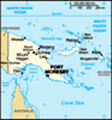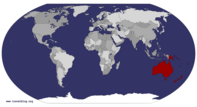Advertisement
Published: December 26th 2005
PNG News
Up the Lazy River March 25, 2005
It was like you would imagine it- floating on a log (in truth it was a long dug out canoe with a 25 hp engine) visiting dusty cathedral proportioned haus tambarans (sometimes called haus boys) with earth tone painted shields and totems. Planti of crocodiles, marsupials and insects in the swamps and amazing birds including white and black herons, and birds of paradise. The ever changing Sepik River is fast flowing, silt coloured and meanders.
Air Nuigini transported me to Wewak to rendezvous with my English fellow explorer Sue Baker (www.lastfrontierarts.com.pg), followed by MAF delivering the two of us to Ambunti to our two guides with the dugout canoe.
“Pilots flying for MAF- the Mission Aviation Fellowship- had the worst crash record. They had a reputation, it must be said, for flying on a wing and a prayer. Some had stickers on their flight bags saying ‘God is my co-pilot.’ Others boasted of flying with a Bible for a flight manual.”
P.114-5 Tree, Isabella (1996) Islands in the Clouds, Travels in the Highlands of New Guinea, Lonely Planet Publication, Hathorne, Australia
With a view of the soggy windsock, we each weighed in on bathroom scales. Our pilot Sam skipped his prayers that morning and Sue claimed she could make out individual leaves on the trees as we turned a sharp left at the mountains and approached the grass runway of Ambunti.
The first of the thirteen villages we visited
was in a lagoon. Twenty-one crocodiles were on site and more than that number of people were sleeping in the house with us. All night the fish was smoking in the kitchen, the newborn pups were mewing under the house on stilts and some of the men were snoring. Lying beneath the mosquito net, the floor was smooth and springy, laid with lengths of split black palms- you can feel the movement with each person’s weight.
I have yet to taste sago, PNG’s traditional starch that represents labour intensive women’s work. After collecting the ripe stems in the jungle, they must be beaten to a pulp. Then it is washed and dried and shaped into a block that crumbles easily.
I had moments of unjustifiable unease when I considered our reliance on our guides -Joe and Damian. Joe a man in a pink T-shirt seemed to be following signs that were blatant to him but completely invisible to me. He would find shortcuts through swamp and we were twisting, turning and ducking to miss the low branches and armies of ants that were ready to catch a ride on the boat. We travelled through a cacophony of sounds

 Joe's sister
Joe's sister
trading bananas for newspaper rollsof birds, insects and frogs, the image of plants doubled by the deep reflection on both sides. Remote, there was little traffic on the upper river, some of Joe’s relatives would approach us trading bananas and fish for beetlenut and cut newspaper that will be used for rolling tobacco.
Joe’s second daughter Domatilda couldn’t print her name. With eight children not all can attend. Some of the villages we saw had no schools. The ones that had a teacher, were church sponsored with only the elite in the village able to pay the school fees for some of their children. Viewing their laundry was truly humbling.
The feeling of being an intruder haunted me throughout the trip. Two white meris visiting village people who have little contact with the outside world. There only connection with the outside world might be a monthly missionary gathering. One man took the opportunity to meet with us in a dark room to tell us the story of the world before man and woman knew each other. Women had sex with dogs and men had it in the ground. He displayed his pornographic sculptures in the hope we might find a buyer.
All white in a black country, carrying kina, we were also allowed to enter men’s special places.They were made with wood, rope and thatch, all perish within 12 years.
When the village sent us off they lined up the length of a canoe and waved us away. The air was still and humid.
PNG News
Sepik River Two April 2, 2005
Ahoo - Upper Sepik Greetings
In the last news I didn’t begin to tell you about the thousand and one PNG nights stories. Perhaps it is because I never heard the end of Joe’s bedtime stories about the moon, and rocks and rivers. The story of the two women with dogs goes something like this.
A long long time ago a time when there were two worlds- one world of all women and one world of all men. The women were washing in the women’s world river when one of their dogs crossed to the other side. A tree had fallen and made a bridge across the river. A dog walked over the bridge. One of the women walked on the fallen tree bridge after her dog. Dog and woman -united in this strange
country; they had sex. A man watched this and said this is not right. You must face the sky. You should have sex this way with me. And so began the new world of men and women.
I only learned the bit about fornicating in the ground because I asked our mysterious storyteller. The story was drawn out as the storyteller chewed beetle nut and lime spit it out in the crack of the floor.
Our host’s feet having never experienced the constraints of a shoe, were thick and splayed like the feet of trolls, they were equipped to grip the slippery clay ground and help us up and down steep hills. When we fell, a triple report of “oh sori tru”. They highlighted my every mistake with yet another apology. (Worse than Canadians they were about always apologizing. And they never mean it.)
In Yessan there was a totem, that speaks to the spirits about moving houses. The young man is prancing in Kawai, a village on a steep ridge on the mighty Sepik River looking over the Highlands. He was one of a group who greeted us in a shower of flower petals when we
walked up the steep clay cliff to the village.
The bald headed woman in Kawai was a widow from the next inland village who managed to marry the Kawai’s bigman’s son. This was an incredible boost for her and her children, as the only protein in the valley had been crickets and now they had access to fish. And the pig in the picture is for sale for K1300 or CAN$515.
Don’t visit Swagup, a village east of April River that is the home of the insect cult people. Crocodiles are the major motive on the Sepik however the art of Swagup usually incorporates the figure of the dragonfly, sago beetle or praying mantis. The Lonely Planet suggests their reputation is of a being ferocious and it is no wonder- they live in a beautiful swamp full of mosquitoes. Gordian, a colleague at the university knows the village well, his brother used to teach there. It is a male dominated village and as soon as a girl is born she is designated to marry one of the male elders. She is not getting out of this village!
I wanted to purchase an artefact in Swagup however they
didn’t have any. They had heard there were not going to be tourists, so they were concentrating on carving their dugout canoes. It takes about 4 weeks to carve out a log and make it become a canoe that will last maybe five years. Some villages have a tradition of carving the front of the canoe, not Swagup.
The man pictured below from Sio has traditional nose holes. The women and baby are also from Sio. Gordian’s cousin is the schoolteacher there. She wanted me to bring back greetings and a picture to him. There is no mail, no contact- it is an honour to pass this information on.
Paru was the furthest west we got on the Sepik. The village is nomadic and our visit was a real shock to their lives The children watched us intently as we ate, went to the outhouse, whatever. They let me take out one of their canoes for a paddle. When we left two children were playing with our Maggi noddle wrappers and the third had our cookie tray on his head. There were no toys and medicine here. There was a half canoe that some children sat in and
even paddle around. They are so skilled, it actually worked quite well.
I will leave you with a picture of a child in a ‘haus tamabarin’ in Maio. There are so many children here and not enough cloth to wipe all those noses!
Advertisement
Tot: 0.136s; Tpl: 0.012s; cc: 5; qc: 50; dbt: 0.052s; 1; m:domysql w:travelblog (10.17.0.13); sld: 1;
; mem: 1.1mb

















Carole
non-member comment
Not a Traveller
Thank you for introducing me to the real world of PNG beyond what I might see as a tourist. I travel virtually and appreciate your bringing the people and their culture to me.